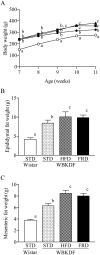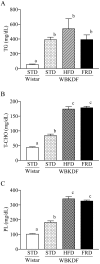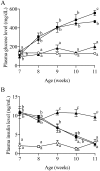Effects of high-fat diet and fructose-rich diet on obesity, dyslipidemia and hyperglycemia in the WBN/Kob-Leprfa rat, a new model of type 2 diabetes mellitus
- PMID: 28442647
- PMCID: PMC5487803
- DOI: 10.1292/jvms.17-0136
Effects of high-fat diet and fructose-rich diet on obesity, dyslipidemia and hyperglycemia in the WBN/Kob-Leprfa rat, a new model of type 2 diabetes mellitus
Abstract
Obesity and type 2 diabetes mellitus (T2DM) are occurring at epidemic-like rates, and these epidemics appear to have emerged largely from changes in daily diet. In the present study, we compared effects of high-fat diet (HFD) and fructose-rich diet (FRD) in WBN/Kob-Leprfa (WBKDF) rats that spontaneously develop obesity, dyslipidemia and T2DM. After a 4-week feeding of each diet, WBKDF-HFD and WBKDF-FRD rats exhibited aggravated obesity and dyslipidemia compared with WBKDF rats fed standard diet (STD). In contrast, hyperglycemia developed in WBKDF-STD rats was significantly inhibited in WBKDF-FRD rats, but not in WBKDF-HFD rats. The present study demonstrated that the 4-week feeding of HFD and FRD caused diet-induced obesity with a distinct phenotype in the glucose metabolism in WBKDF rats.
Keywords: WBN/Kob-Leprfa rat; diet-induced obesity; fructose-rich diet; high-fat diet; type 2 diabetes.
Figures



Similar articles
-
Characteristics of WBN/Kob diabetic fatty rats supplemented with a fructose-rich diet as a metabolic syndrome model: response to a GLP-1 receptor agonist.J Vet Med Sci. 2018 Oct 10;80(10):1515-1523. doi: 10.1292/jvms.18-0306. Epub 2018 Aug 31. J Vet Med Sci. 2018. PMID: 30175725 Free PMC article.
-
Fructose prevents the development of hyperglycaemia in WBN/Kob diabetic fatty rats via maintaining high insulin levels.Clin Exp Pharmacol Physiol. 2022 May;49(5):577-585. doi: 10.1111/1440-1681.13629. Epub 2022 Feb 22. Clin Exp Pharmacol Physiol. 2022. PMID: 35108433
-
Effects of high-sodium intake on systemic blood pressure and vascular responses in spontaneously diabetic WBN/Kob-Leprfa/fa rats.Clin Exp Pharmacol Physiol. 2017 Feb;44(2):305-312. doi: 10.1111/1440-1681.12700. Clin Exp Pharmacol Physiol. 2017. PMID: 27862163 Free PMC article.
-
An Overview of Murine High Fat Diet as a Model for Type 2 Diabetes Mellitus.J Diabetes Res. 2016;2016:2902351. doi: 10.1155/2016/2902351. Epub 2016 Jul 31. J Diabetes Res. 2016. PMID: 27547764 Free PMC article. Review.
-
Alpha-lipoic acid and its protective role in fructose induced endocrine-metabolic disturbances.Food Funct. 2019 Jan 22;10(1):16-25. doi: 10.1039/c8fo01856a. Food Funct. 2019. PMID: 30575838 Review.
Cited by
-
An 8-week ketogenic diet improves exercise endurance and liver antioxidant capacity after weight loss in obese mice.Front Nutr. 2023 Dec 29;10:1322936. doi: 10.3389/fnut.2023.1322936. eCollection 2023. Front Nutr. 2023. PMID: 38223504 Free PMC article.
-
Characterization of autochthonous lactobacilli from goat dairy products with probiotic potential for metabolic diseases.Heliyon. 2022 Aug 28;8(9):e10462. doi: 10.1016/j.heliyon.2022.e10462. eCollection 2022 Sep. Heliyon. 2022. PMID: 36091951 Free PMC article.
-
The Association Between Plasma Fatty Acid and Cognitive Function Mediated by Inflammation in Patients with Type 2 Diabetes Mellitus.Diabetes Metab Syndr Obes. 2022 May 6;15:1423-1436. doi: 10.2147/DMSO.S353449. eCollection 2022. Diabetes Metab Syndr Obes. 2022. PMID: 35573864 Free PMC article.
-
Molecular biochemical aspects of salt (sodium chloride) in inflammation and immune response with reference to hypertension and type 2 diabetes mellitus.Lipids Health Dis. 2021 Aug 1;20(1):83. doi: 10.1186/s12944-021-01507-8. Lipids Health Dis. 2021. PMID: 34334139 Free PMC article. Review.
-
Characteristics of WBN/Kob diabetic fatty rats supplemented with a fructose-rich diet as a metabolic syndrome model: response to a GLP-1 receptor agonist.J Vet Med Sci. 2018 Oct 10;80(10):1515-1523. doi: 10.1292/jvms.18-0306. Epub 2018 Aug 31. J Vet Med Sci. 2018. PMID: 30175725 Free PMC article.
References
MeSH terms
Substances
LinkOut - more resources
Full Text Sources
Other Literature Sources
Medical
Research Materials
Miscellaneous

